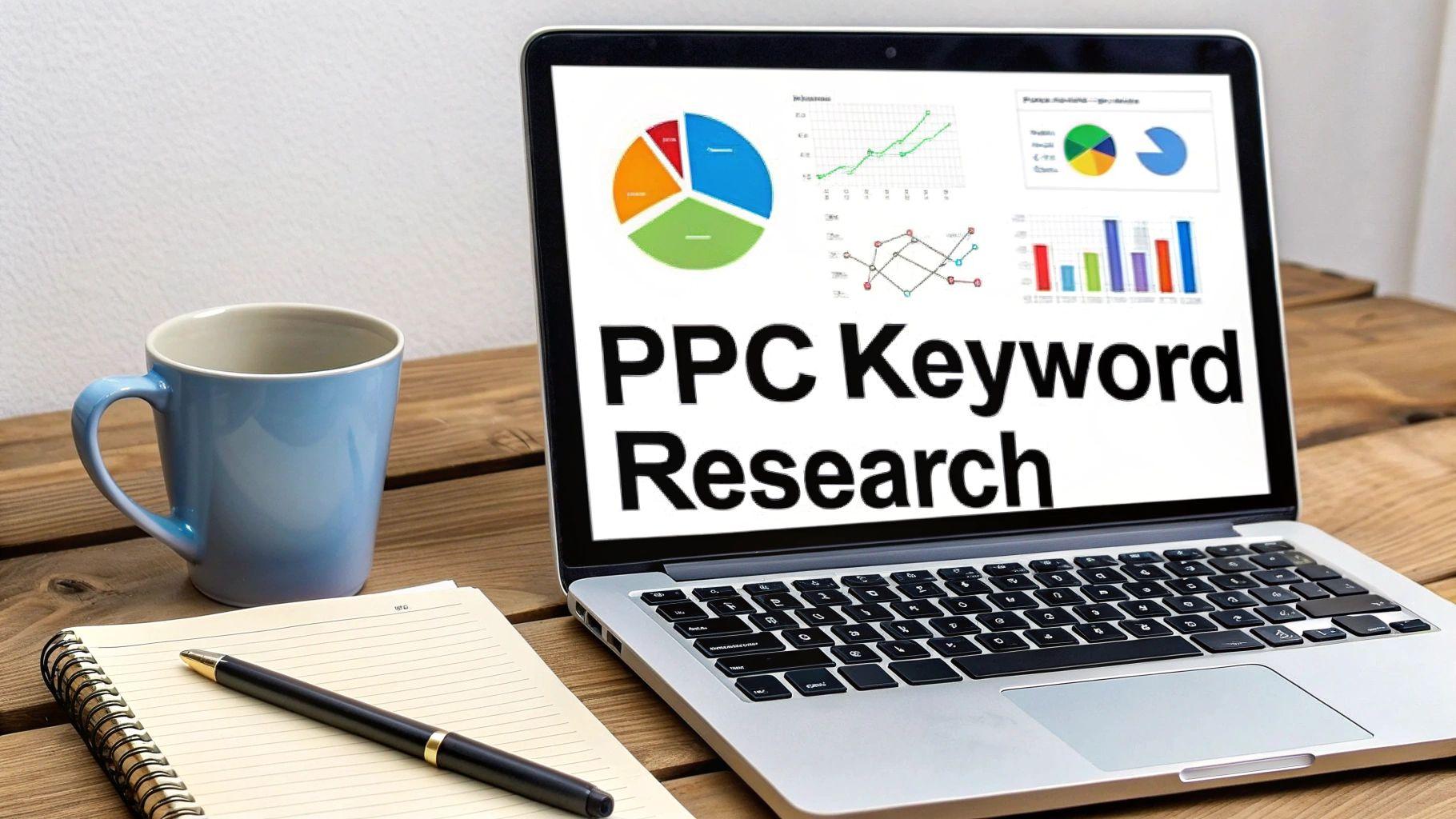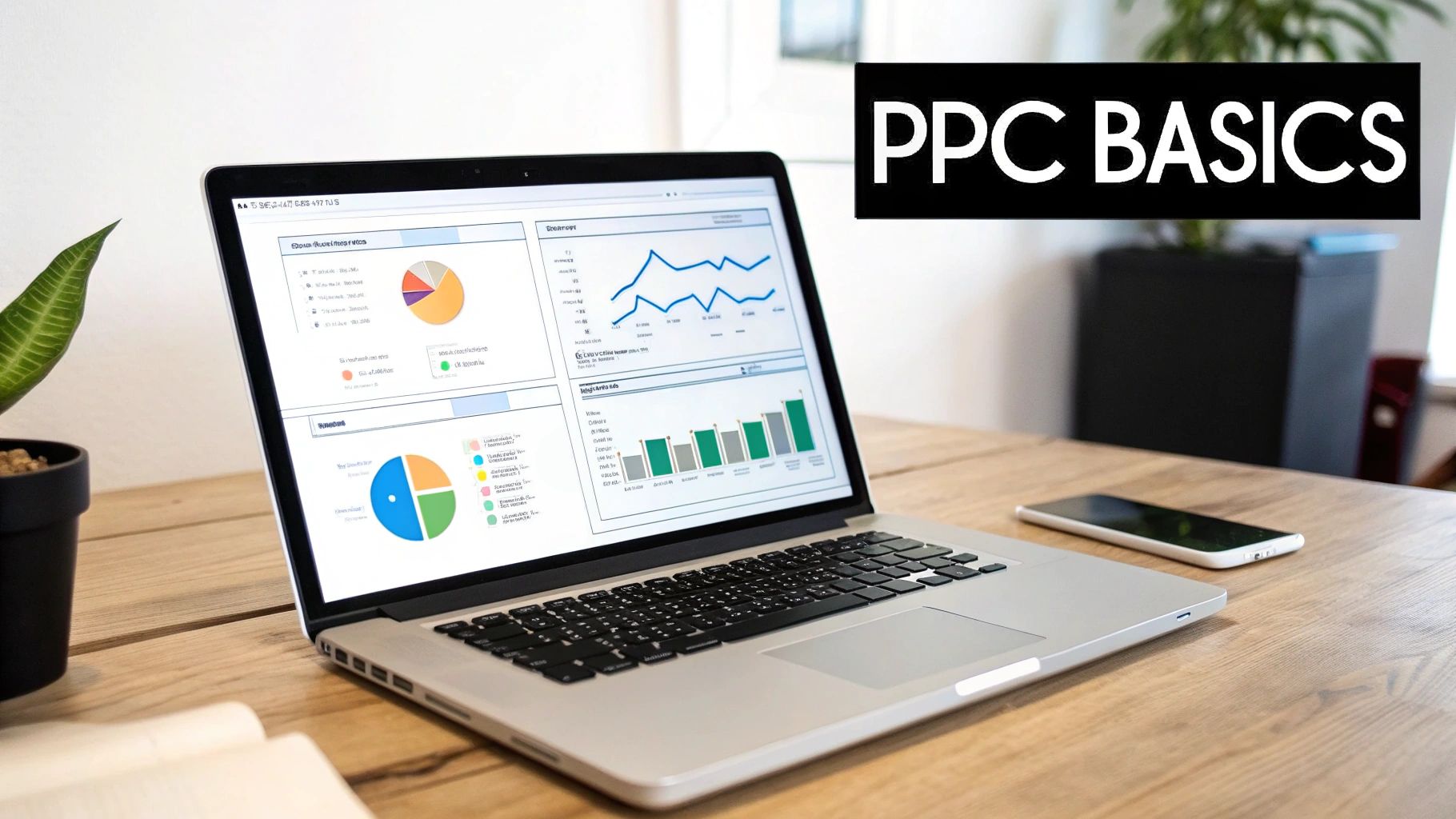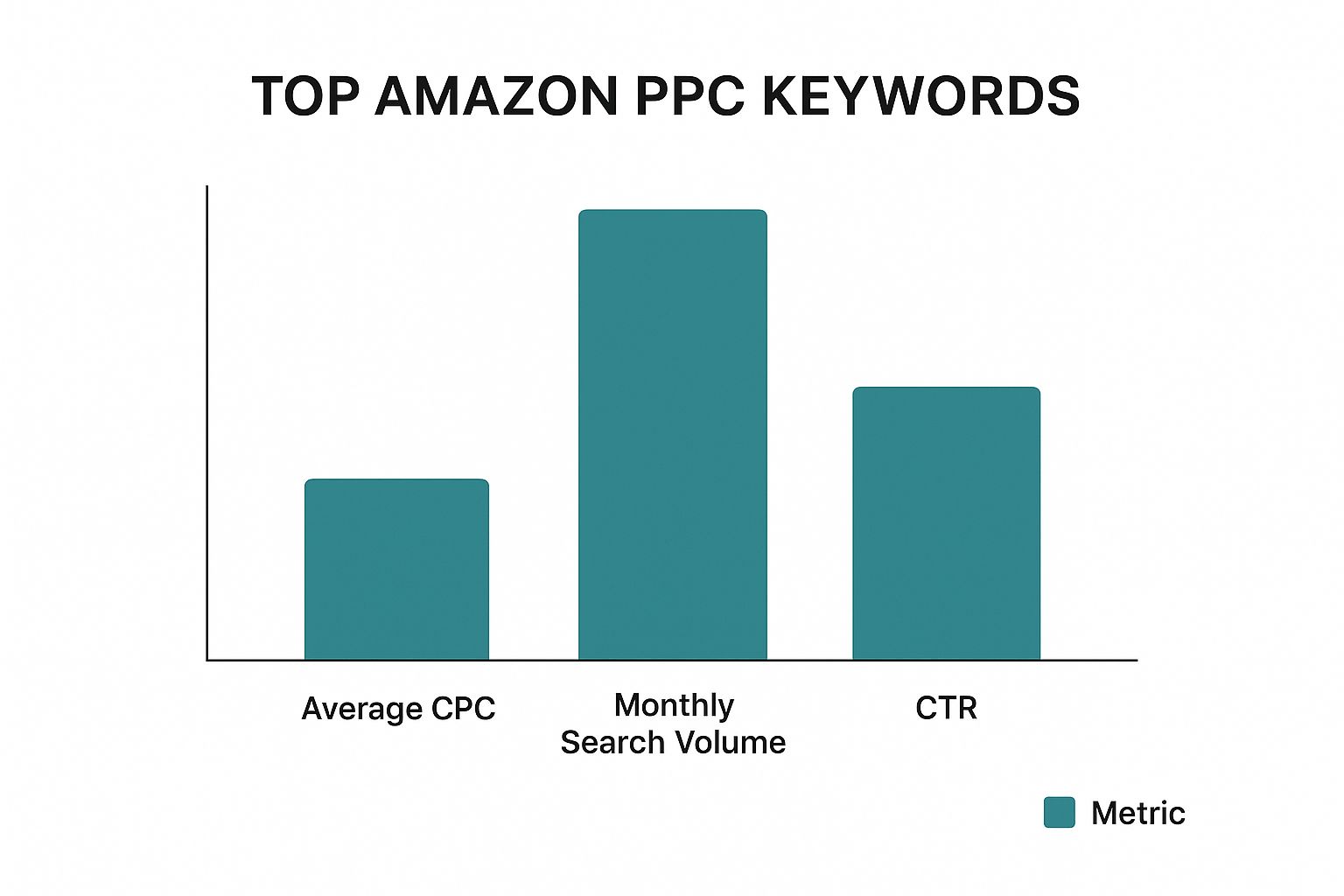Amazon PPC Keyword Research That Actually Works
Master Amazon PPC keyword research with our guide. Find profitable keywords, lower your ACoS, and get actionable strategies that drive sales and ROI.

Solid Amazon PPC keyword research isn't just about pulling a list of terms. It's about laying a strategic foundation before you even open a keyword tool. The real magic happens when you get clear on your advertising goals and truly understand how your customers search. This is how you make every ad dollar count.
Build Your Keyword Strategy Before You Search

Diving headfirst into keyword tools without a plan is a classic mistake. I’ve seen it time and time again—it's a surefire way to burn through your budget with little to show for it. The campaigns that consistently deliver results are always built on a strategy tied to specific business goals.
So, before you start searching, you need a clear answer to one simple question: What am I trying to achieve with this campaign?
Your answer completely changes how you'll approach keyword selection. For instance, launching a brand-new product requires a totally different mindset than optimizing an established one for pure profit.
- Launching a new product? Your main goal is getting seen and gathering data. You'll want to target broader, higher-volume keywords to cast a wide net, generate impressions, and discover exactly how shoppers are looking for a product like yours.
- Focusing on profitability? Here, it's all about maximizing your return. You'll be hunting for highly specific, long-tail keywords. These terms might have lower search volume, but they signal that a shopper is ready to buy.
Get Inside Your Customer’s Head
The next piece of the puzzle is to put yourself in your customer's shoes. This doesn't require a complicated, formal buyer persona. It's about practical empathy.
Think about your ideal customer. What problem does your product solve for them? What words would they actually type into the search bar?
Let's say you're selling a high-end, insulated coffee mug. A busy professional commuting to work might search for a "leakproof travel mug for commute." On the other hand, a college student might be looking for a "durable coffee mug for backpack." Each phrase points to a different customer, a different need, and a different keyword opportunity you can target.
Aligning your keyword choices with customer intent and your specific campaign goals is crucial for building a smart PPC strategy. The table below breaks down how to match different keyword types with your advertising objectives.
Matching Keyword Intent With Your Campaign Goals
| Campaign Goal | Primary Keyword Type | Example Keyword | Expected Outcome |
|---|---|---|---|
| Increase Brand Awareness | Broad, High-Volume | "coffee mug" | High impressions, low CTR, discover new search terms |
| Launch a New Product | Mid-Tail, Descriptive | "insulated travel mug" | Gather performance data, gain initial sales velocity |
| Drive Profitable Sales | Long-Tail, High Intent | "16 oz stainless steel travel mug leakproof" | High conversion rate, lower ACoS, strong ROI |
| Defend Brand/Market Share | Branded | "YourBrand coffee mug" | Protect against competitors, capture high-intent buyers |
By thinking through these scenarios, you can build a more targeted and effective campaign structure from the start.
A foundational element of successful Amazon PPC keyword research is aligning keyword choices with your advertising goals and the target audience's search behavior. It's about selecting keywords not merely by relevance but by analyzing search intent and conversion potential. For instance, sellers launching new products might prioritize high-volume keywords to build visibility, whereas those focusing on profitability aim for long-tail keywords with lower search volume but higher conversion rates. This detailed approach improves ad relevance, lowers advertising costs, and maximizes conversion potential. You can discover more insights about this strategy at BeBoldDigital.com.
This strategic prep work turns your research from a guessing game into a targeted mission. You'll know exactly what kinds of keywords to hunt for and which ones to prioritize. This clarity is what separates campaigns that just spend money from those that drive real, sustainable growth. If you're serious about winning on Amazon, taking the time to define your goals and understand your customer isn't just a suggestion—it's non-negotiable.
Find High-Impact Keywords From Every Angle
Now that you have a strategy, it’s time to get your hands dirty and start digging for keywords. A classic rookie mistake is grabbing a list from one tool and calling it a day. To build a campaign that actually performs, you need to pull ideas from several different places. This approach gives you a rich, diverse list of terms that captures shoppers at every stage of their buying journey.
Your best starting point is always your own data. If you’ve been running any automatic campaigns (and you should be), your Amazon Search Term Report is a treasure trove. This isn't guesswork; the report shows you the exact search queries real customers typed right before they clicked your ad. It's like a direct window into their thought process.
Mine Your Customer Search Term Data
Making a habit of checking this report is crucial. You’re looking for what’s already clicking with customers—literally. Pinpoint the search terms that have led to sales at a profitable Advertising Cost of Sale (ACoS). These are your proven winners. Move them into a dedicated manual campaign where you can bid on them more aggressively and have total control.
Just as important, you'll spot the duds. You’ll find irrelevant terms that are just eating up your budget. Let's say you sell high-end leather dog collars. You might see clicks coming from searches like "cheap nylon dog collar." This is a clear signal to add "cheap" and "nylon" to your negative keywords. It's one of the quickest ways to stop wasting money.
Your Search Term Report is the single most authentic source of high-intent keywords available. These aren't just estimates; they are the literal words your customers used to find and buy your product. Making these terms a priority is one of the fastest paths to a more profitable campaign.
Ethically Spy on Your Competitors
Next, it’s time to see what the competition is up to. I’m talking about the sellers who always seem to be sitting in those top sponsored spots. They've already spent a ton of money testing and figuring out what works. You can learn from their investment by using a reverse ASIN lookup tool.
Tools like these let you plug in a competitor's product ASIN and spit out a list of keywords they’re ranking for, both organically and in their ads.
Here’s what you should be looking for when you dive into their data:
- Highly relevant keywords that are clearly driving their sales and also perfectly describe your own product.
- Long-tail opportunities you might have missed, like "waterproof leather dog collar for large dogs." These specific phrases often convert really well.
- Keyword gaps. Maybe your product has a feature they lack. You can target a specific keyword around that feature to gain an edge.
The goal here isn't to just copy-paste their keyword list. It's about understanding the competitive landscape and finding smart, strategic openings for your own products.
Uncover Hidden Gems in Amazon Search
Don't forget to use Amazon itself as a powerful research tool. The autocomplete feature in the Amazon search bar is a surprisingly effective way to find popular search terms, especially longer ones.
Just start typing in your main keyword, like "leather dog collar," and watch the suggestions Amazon provides.
These aren't random; they're based on what thousands of other customers are searching for right now. Jot down all the relevant variations, especially those that include specific features, colors, or uses.
By combining these three methods—analyzing your own data, peeking at competitors, and using Amazon’s own suggestions—you’ll build a far more comprehensive keyword list. This groundwork is what sets you up for a truly effective and profitable PPC campaign.
How To Analyze and Prioritize Your Keyword List

Alright, you've done the digging and now you're staring at a massive list of potential keywords. This is the moment where the real work—and the real money—is made in Amazon PPC. A long, unorganized list isn't an asset; it's just raw data. It's time to refine it into a sharp, strategic tool that drives sales instead of just draining your budget.
Every single keyword on that list needs to pass through three crucial filters: relevance, search volume, and purchase intent. If you miss even one of these, you're essentially gambling with your ad spend. This is how you separate the winners from the wallet-drainers.
Is the Keyword Actually Relevant?
This first filter sounds simple, but it's where a lot of sellers trip up. You have to be brutally honest here. For every keyword, ask yourself: "Does this term perfectly describe my product?" Not "sort of" or "close enough." A mismatch is a surefire way to pay for clicks that have zero chance of converting.
Think about it this way: sellers who just chase high-volume terms without a second thought often find themselves struggling to break even. On the flip side, those who meticulously filter for relevance, cost-per-click, and conversion potential can see their sales jump by over 40%.
Imagine you’re selling a $25 mid-range laptop sleeve, but you’re bidding $2.50 per click on "luxury leather laptop bags." That’s a classic mismatch. You're paying for clicks from shoppers whose expectations (and budgets) are completely different from what your product offers. You can learn more about how to avoid these costly keyword mismatches on Ecomclips.com.
Balancing Search Volume and Purchase Intent
Next up, you need to weigh search volume against the customer's intent to buy. It's so tempting to go after keywords with huge search numbers, but that's often a trap.
A broad term like "how to clean leather" might get tons of searches every month. But the person typing that is looking for a tutorial, not to buy your leather cleaning kit. That's low-intent traffic.
Now, consider a long-tail keyword like "buy red leather dog collar for small dogs." The search volume will be a fraction of the first example, but the intent is crystal clear. That person has their credit card in hand. That’s high-intent traffic, and it’s infinitely more valuable to your business.
I see this all the time: sellers prioritize raw search volume over actual buyer intent. A few clicks from a super-specific, high-intent keyword are worth a hundred clicks from a vague, informational term. Remember, your goal is profitable sales, not just website traffic.
To make this practical, I recommend creating a simple scoring system in a spreadsheet. It forces you to be objective. Rate each keyword from 1 to 5 across these three areas:
- Relevance Score (1-5): How perfectly does this term describe your product? (5 is a perfect match).
- Intent Score (1-5): Does it scream "I want to buy"? Look for words like buy, for, best. Or is it just research-focused, using words like how, what, or ideas?
- Search Volume Score (1-5): Is there enough traffic to matter, but not so much that it's insanely competitive and broad?
After scoring everything, the keywords with the highest combined totals should be at the top of your list. These terms hit that sweet spot of high relevance, strong buying intent, and reasonable search volume. That's the foundation for a PPC campaign that actually makes you money.
Build Your Campaigns for Control and Profit
You've done the hard work and have a solid list of keywords. That's a great start, but it's just a list. How you organize those keywords into campaigns is what actually drives profit and gives you control over your ad spend.
Tossing all your keywords into one massive campaign is a common mistake, and frankly, it's a recipe for disaster. You'll blow through your budget and have no idea what's working.
Think of it like organizing a toolbox. You wouldn't just dump every screw, nail, and wrench into one big bin. A clean, logical campaign structure is the engine of a successful Amazon PPC strategy. It ensures your ad is always hyper-relevant to what the customer is searching for, which Amazon rewards with better ad placements and lower costs.
This visual shows the trade-offs you'll constantly be making between different types of keywords. It’s all about balancing search volume, cost, and how likely someone is to click.

As you can see, the big-ticket, high-volume keywords often cost more per click and might have a lower click-through rate (CTR). On the flip side, those super-specific, long-tail keywords can get fantastic CTRs even if fewer people are searching for them.
Group Keywords by Theme for Hyper-Relevance
The bedrock of a killer campaign structure is the themed ad group. This simply means grouping a handful of very, very similar keywords together.
Let’s say you sell a "waterproof dog bed." You'd want a specific ad group dedicated just to keywords like these:
- "waterproof dog bed for large dogs"
- "large waterproof dog bed"
- "dog bed waterproof liner"
Why? Because now you can write an ad that talks directly to someone searching for a waterproof bed. This tight focus is what boosts your performance. Trying to manage an ad group with hundreds of loosely related terms is a nightmare—you can't optimize effectively.
Use Match Types to Find and Scale Winners
One of the most powerful strategies I use is building campaigns around Amazon's keyword match types. This gives you a system for finding new, profitable search terms while protecting your budget on the keywords that are already making you money.
My Go-To Strategy: I always create separate campaigns for Broad, Phrase, and Exact match keywords. This level of separation is non-negotiable for me. It provides granular control over bids and budgets, letting me manage each stage of a keyword's journey from discovery to profitable scaling.
Think of it as a "waterfall." Your Broad Match campaign is the wide net, catching all sorts of new customer search terms. When you comb through your Search Term Report and find a winner, you promote it. First, you add it as a Phrase Match in its own campaign. If it keeps performing well, you graduate it again to an Exact Match in a high-priority campaign where you can bid more aggressively.
This creates a self-sustaining optimization loop.
The final piece is being relentless with Negative Keywords. As you find irrelevant search terms wasting your money—like "cheap" if you sell a premium product, or "cat" for your dog bed—add them as negatives immediately. This instantly plugs budget leaks and funnels your ad spend toward clicks that actually have a chance to convert. It's this disciplined, structured approach that gives you the control you need to scale.
Choosing The Right Keyword Match Type
Deciding which match type to use can feel tricky at first, but each has a distinct job. This table breaks down how I think about them and where they fit into my overall strategy.
| Match Type | Best For | Level of Control | Typical Use Case |
|---|---|---|---|
| Broad | Keyword discovery & research | Low | Casting a wide net in an "Auto" or "Research" campaign to find new, unexpected customer search terms. |
| Phrase | Balancing reach and relevance | Medium | Targeting a specific sequence of words while allowing for variations before or after. Good for testing proven terms. |
| Exact | Maximum control & high-intent traffic | High | Bidding aggressively on your most profitable, proven keywords. This is where your "winners" live. |
Ultimately, a mix of all three is essential. Broad match finds the opportunities, Phrase match validates them, and Exact match helps you scale the profits. Using them together is how you build a campaign structure that not only performs but also gets smarter over time.
Keep Refining and Optimizing Your Keywords

Here’s a hard truth: your Amazon PPC work isn't done just because your campaigns are live. In fact, that's really just the starting line. The sellers who consistently turn a profit treat PPC as a constant cycle of analysis and improvement, not a task you can just "set and forget." This ongoing refinement is what separates the pros from the people who just burn through their ad budget.
The most critical tool for this is your Amazon Search Term Report. Think of it as a direct line into your customers' minds. It shows you the exact words and phrases shoppers are typing into the search bar right before they find and click on your ad. If you want to succeed long-term, getting into the habit of reviewing this report weekly isn't just a good idea—it's non-negotiable.
Harvest Your Winners, Prune Your Losers
Every time you sit down to review your reports, you have two main jobs: find the winners and cut the losers. It’s a straightforward but incredibly powerful process that keeps your campaigns healthy and your budget pointed squarely at what's actually working. You’re looking for clear signals in the data that tell you exactly what to do next.
Finding Your Winners:
- Hunt for search terms that have driven multiple sales at a good Advertising Cost of Sale (ACoS).
- Take these proven customer search terms from your discovery campaigns (Broad or Phrase match).
- Move them into their own Exact match campaign. Here, you can bid more aggressively to own that placement and maximize sales.
Cutting Your Losers:
- Pinpoint any search terms that are getting clicks but have zero sales. These are budget-bleeders, pure and simple.
- Immediately add these irrelevant or unprofitable terms to your Negative Keyword list. This stops the bleeding and prevents your ads from showing up for those searches ever again.
This simple loop ensures your money is constantly being reallocated from terms that are wasting your cash to the ones that are proven to convert.
Use Modern Tools to Track Performance
While Amazon's own reports are essential, a new generation of advanced Amazon PPC keyword research tools gives you a much deeper level of control. These platforms provide data that was unimaginable just a few years ago, offering a huge competitive edge. I'm talking about features like daily keyword rank tracking, more accurate search volume estimates, and even heat maps showing which keywords are landing you those top-of-search ad placements.
For example, imagine being able to see if your ads are ranking in the top 10 for your most important keywords every single day. This level of detail allows you to make incredibly precise decisions. You can confidently push more budget toward terms that are performing well and pull back from those that aren't, making your campaigns far more responsive and effective. You can learn more about these advanced tracking strategies to get a real edge on your competition.
The most powerful insight you'll ever get is seeing the difference between a keyword you think should work and a search term a customer actually used to buy your product. The Search Term Report is what closes that gap, turning your assumptions into hard data.
Ultimately, this ongoing cycle of research, analysis, and optimization is the engine that drives profitable Amazon advertising. It transforms your campaigns from static guesses into smart, dynamic systems that adapt to real customer behavior. When you commit to this process, you’re not just running ads—you’re building a powerful, self-sustaining growth machine for your brand.
Your Amazon Keyword Research Questions Answered
Even with the best game plan, you're always going to run into questions when you're in the trenches managing your Amazon PPC campaigns. It just comes with the territory. Let's dig into some of the most common ones I hear and give you some straightforward, practical answers.
How Many Keywords Should I Put In An Ad Group?
This question comes up a lot, and the honest answer is there's no single magic number. The real goal isn't to hit a specific count; it's to create super-focused, tightly-themed ad groups.
As a solid rule of thumb, aim to group 5-15 highly similar keywords together. For instance, "red leather dog collar," "leather dog collar red," and "dog collar red leather" are perfect for a single ad group. Keeping them this tight means your ad is always spot-on for the search term. This directly boosts your click-through rate (CTR) and ad quality, which in turn helps lower what you pay per click.
Resist the urge to dump hundreds of sorta-related keywords into one massive ad group. It feels like you're covering more ground, but all you're really doing is killing your relevance and making it a nightmare to optimize anything effectively.
How Often Should I Update My Keywords?
Think of your amazon ppc keyword research as more of a garden than a building. It needs constant tending, not just a one-and-done setup. How often you prune and plant depends on where your campaign is at.
When you're launching a brand new product, you'll obviously do a huge keyword deep-dive upfront. But after that? You need to be living in your Search Term Report at least weekly, maybe bi-weekly.
These regular check-ins are crucial. They let you:
- Harvest new winners: You'll uncover the exact phrases customers are using to buy your product. Add these as new Exact match keywords.
- Stop bleeding cash: Find all those irrelevant terms chewing up your budget with clicks but no sales. Immediately add them to your Negative Keyword list.
On top of that, it's smart to do a broader market and competitor research session every quarter. This helps you catch new trends and find keyword opportunities your competition hasn't discovered yet. It’s this consistent rhythm that keeps your campaigns healthy and ahead of the curve.
What Is A Good ACoS?
Ah, the million-dollar question. The truth is, a "good" Advertising Cost of Sale (ACoS) is completely unique to your product's profit margins and what you're trying to achieve with a specific campaign. One of the biggest mistakes I see is sellers chasing some random low number without even knowing their own break-even point.
The only ACoS that truly matters at first is your break-even ACoS. This is the tipping point where you're not making money, but you're not losing it either. Every percentage point below this number is pure profit.
Figuring this out is pretty simple. Just use this formula: Break-Even ACoS = (Product Price - Cost of Goods Sold - Amazon Fees) / Product Price
Once you have that number, you can set an intelligent target ACoS.
- Focused on Profit? Your target ACoS absolutely must be below your break-even point.
- In a Launch or Growth Phase? You might decide you're okay with a higher ACoS—one that's even unprofitable—for a short time to grab market share and build up sales history.
A good ACoS is never just a number you pull out of thin air. It's a strategic target that lines up perfectly with what you need your business to do.
At Headline Marketing Agency, our job is to turn these complex questions into clear, profitable strategies. We use a data-first approach for Amazon advertising that looks past vanity metrics to focus on what actually drives sustainable growth. If you're tired of guessing and want to build a PPC machine that really works, let's connect.
Ready to Transform Your Amazon PPC Performance?
Get a comprehensive audit of your Amazon PPC campaigns and discover untapped growth opportunities.